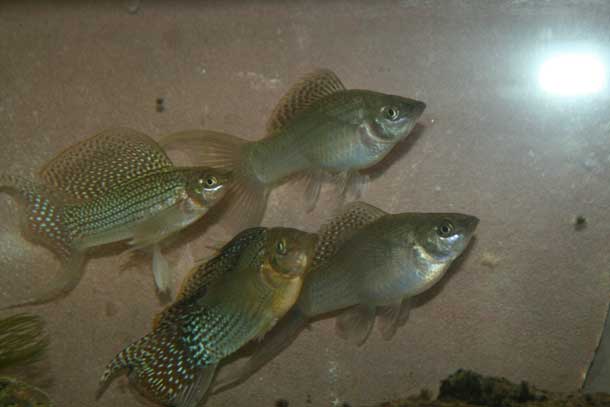Ashley and I processed the Green Lyretail Sailfin Mollies today.
This a is relatively old strain of ours, having been developed in the late 1990s by crossing some Red Leopard Lyretail Mollies from an Asian farm with Poecilia latipinna, San Antonio River, which we had collected in 1998. As usual with a cross of a wild sailfin molly to a commercial line, the offspring were generally yellowish and with muddy brown blotches. But, the F2 generation had some Green Sailfin Lyretails. They weren’t great sailfins or lyretails, but a few generations of selection led to the fish in the photo.
As with most of our mollies, we maintain the Green Lyretail Sailfins in three 55 gallon vats. One vat houses the breeders, usually 6 males and 40 or so females. Another vat has the fry and juveniles from the previous breeding colony. And yet another vat is home to the young adults and adults we sell (this is called the “sale vat”).
About every 90 days we breakdown and clean the vats, inventory the fish, and reconstitute the breeding colony. First we process the sale vat, then the fry/juvenile vat. We set aside any really good fish as potential breeders. The rest are counted and placed either in the sale vat, which contains all the young adults and adults we intend to sell, or into the fry/juvenile vat to grow up. After these two vats are done, we break down the breeder vat, inventory the breeders and place the fry and juveniles into the fry/juvenile vat. The breeder vat is set up with a netting cage in the middle as a refuge for the fry. The breeders are returned and any losses are made up from the fish previously set aside as potential breeders.
In this strain, we select for males with large sailfins, wide angled lyretails with straight and long extensions, nice coloration, good confirmation, and good health. As long as our breeder males are in good health, we keep them in the breeding colony and don’t replace them (unless a young male is much superior, then the worst of the old males is replaced). With females we like robust, healthy females with wide angled and straight lyretails. Again, unless we have some spectacular youngsters we keep the older females. Why? Because we like to select for longevity. Fish that live longer are generally healthier. So, by selecting for longevity, we are selecting for health.


David Lund says
Hello, I read your article about trying to develop blue sailfin mollies. I visited three islands in Hawaii (Oahu, Kauai, and Maui) in 1983, and in an outdoor pond on one of those islands I saw huge blue sailfins, with a red edge at the top of their dorsal fins. Perhaps they still exist. If so, maybe it’s time for you and your wife to take a “business trip”.
charles says
David, We’ve been considering a trip to Hawaii to visit fish friends there. When we go, I’ll certainly look for the mollies you saw. I suspect they are Poecilia velifera introduced decades ago. I’m always looking for new genetic material and would like to have them.
stan friedmann says
Are you selling female sailfin mollies. I need 4 mature ones. my 2 males are silver….
Thanks
charles says
Stan, Yes, we sell male and female mollies separately, so you can order females only. We have silver sailfin, silver freckle sailfin, and silver lyre tail sailfin mollies available. Females are sold as young adults or adults. Young adults are sexable but not fully mature. Adults are fully mature.
Charles
Erick says
Hello!?
I want to know how to buy and receive in Brazil.
charles says
We don’t currently ship to Brazil.
Mark Wilson says
David: I raise fish and have an aquarium service business in the Houston area. I have collected sailfin mollies in the hill country, and along the Texas coast since childhood. I have greenhouse with 500 gallon vats in which I grow out fish for my customers. I am looking to purchase about 25 Green Sailfins this spring. I no longer have time to go collecting. I have seen your fish and have always wanted some. Can you help me out?
charles says
Mark,
We raise all three wild species of sailfin mollies and many commercial strains, mostly hybrids of the wild fish. We also supply aquarium maintenance companies with large cichlids. Send me your business information and I’ll forward our wholesale list to you.
Charles
steve marshall says
i am heading to San Antonio next week and wonder it i ca n catch my own wild sailfin mollies or where i can buy some
charles says
Steve,
I’m sorry for the tardy reply. I didn’t notice the comment. I hope you are still in San Antonio.
Poecilia latipinna is found throughout most of Texas. The San Antonio River in downtown SA (the Riverwalk) has many of them. They aren’t difficult to catch with a dip net, but you are required to have a Texas fishing license to do so legally.
Good luck!
Charles
Daniel says
I’ve caught wild mollies not far from Austin it took me a while to find these fish but I did it. There very beautiful. I was hoping if you could tell me where to catch the San Antonio wild mollies exactly. Thank you.
charles says
Daniel,
I’ve caught them on the Riverwalk in San Antonio, but they are also easily accessible in Brackenridge Park in San Antonio. Here’s a link for the park: http://www.sanantonio.gov/parksandrec/directory_brackenridge.aspx. Be sure you have a valid Texas fishing license before collecting.
Charles
Erick says
Molly would like to have this in my aquarium .
How do I buy?
charles says
We sell these fish on our website, but are currently out of them. Check back in a few weeks.